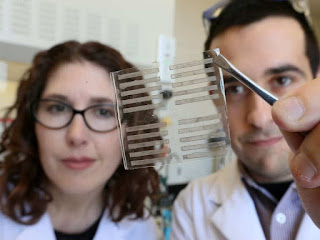Students claim prizes at chemistry conference

Professor Stephen Loeb congratulates prize-winning chemistry students Mitchell DiPasquale and Jacqueline Gemus.
Two UWindsor students received honours at the Southern Ontario Undergraduate Chemistry Conference, March 18 at York University.
Jacqueline Gemus, a student in professor Rob Schurko’s research group, won first prize in physical chemistry.
Dr. Schurko says Gemus’ main area of interest is the mechanochemical synthesis of porous framework materials known as zeolitic imidazolate frameworks (ZIFs) and the use of solid-state nuclear magnetic resonance to monitor the formation of these amazing framework materials.
“Jacqueline has made a wide array of new materials, and this work will be the first that describes ZIFs with mixed linker ligands which are simply made by vigorous grinding — a great example of ‘green chemistry,’ which uses no solvents and produces high yields of the final materials,” says Schurko.
Mitchell DiPasquale, a student from the laboratory of Bulent Mutus, head of chemistry and biochemistry, claimed second place in bio/medicinal chemistry.
Dr. Mutus calls DiPasquale an amazing undergraduate student who has excelled in protein chemistry research and has single-handedly explored the role of a repeating set of amino acids in the enzyme that produces sulfide in the human body.
“His research has, for the first time, shown that this amino acid motif plays a role in the regulation of sulfide production, as well as being responsible for a totally new previously undiscovered activity for this enzyme,” he says.
The University of Windsor was represented at the colloquium by a contingent of 14 undergraduate students from the Department of Chemistry and Biochemistry. A total of 127 presentations by students represented every university in southern Ontario, plus Laurentian and Nipissing.
See the original story at:






